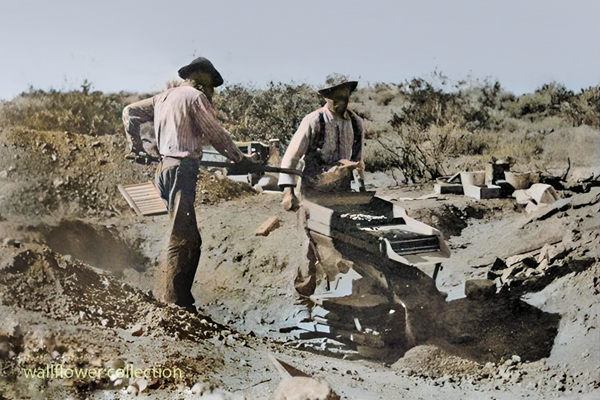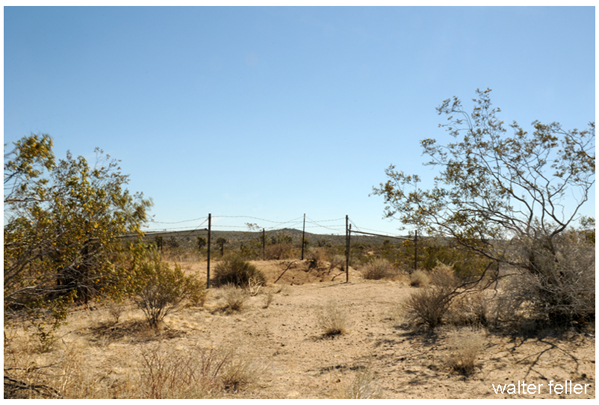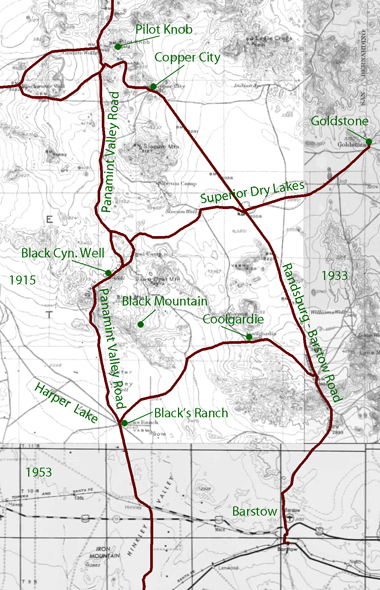San Bernardino County:
Coolgardie
A0bout May, 1900, placer gold was discovered in shallow gravel 20 miles north of Barstow by Dick Duncan. Duncan was one of the co-discoverers of gold at Kramer about this same time. He named his discovery the Black Nugget after a famous mine in South Africa. Another claim, the Coolgardie, was named after a famous Australian gold camp. In August, 1900, ten men were operating 2 dry-placer machines at Black Nugget Camp, and the Engineering and Mining Journal reported that, "The whole country is said to be located from Coolgardie to Lane's mill, both west and south of Camp Vera." 277
Dry-placer machines do not work with wet sand, thus during the winter of 1900-1901, the camp was shut down. In June, 1901, they began again. Northing more is heard from the placers at Coolgardie until 1908. In October, the Coolgardie Mining Company, which had devised a dry washer capable of treating 100 tons of gravel a day, was working here. In 1909, Coolgardie was described as "a small mining settlement, the cabins of the miners scattered over several square miles of dry-placer workings." In 1911, it was stated $100,000 in gold had been taken from the rich placers at Coolgardie. 278
Reference was made above to Lane's Mill, and Camp Vera. Lane's Mill, located at Lane's Well (now known as Noble Well), is at best vaguely described. In 1909 Lane's Mill was still standing, and a photo shows several structures. A description of the well in 1917 fails to mention the mill. It is not known what mines supported this mill. 279

The Camp Vera group of claims were 6 mines northeast of Lane's Mill. At this copper mine, owned by W. J. Rodgers, there were 20 shafts from 10 to 60 feet deep. There is no record of mining at this mine since 1902. 280
Just 3 miles north of Lane's Well (and one and a half miles north of William's Well), M. J. Smith (see Old Woman Mountains section) discovered the First Chance Mine in 1906. This mine, also known as the Golden Eagle, was worked by Smith through 1911, and in November, 1913, there was a 12 by 24 foot building, arrastre and blacksmith shop on the property. Reportedly, $3,000 in gold was taken from here. 281
William's Well, not far from Coolgardie, was the site of a placer operation that had probably been going on since the excitement in 1900. In 1910, four men were working the gravel there and making good wages. This well probably was dug in late 1909 by M. W. H. Williams, a resident of Redlands since about 1898. He and his associates spent a number of months in 1909 examining mining property north of Barstow. By digging the well, they enabled many new prospectors to work near there, since water was scarce. The dry placer operations are still worked from time to time. 282

Coolgardie
This is a dry-placer mining district in western San Bernardino County about 15 miles northwest of Barstow. The area was mined intermittently from around 1900 to 1915, with a total output valued at about $100,000. The principal operator was the Cool Gardie Mining Company, which operated a battery of gasoline- powered dry washers. Several two-man operations employed single dry washers or rockers (see photo 77). Minor prospecting was done in the district during the 1920s and 1930s. The deposits are in a broad valley; the gold apparently was derived from veins in granitic rocks that are to the east and northeast.
- California Division of Mines and Geology
(...)